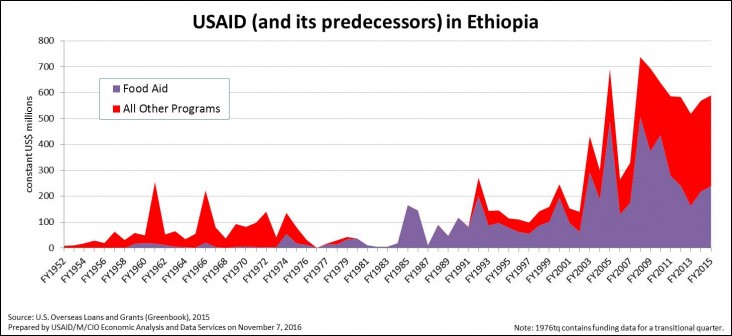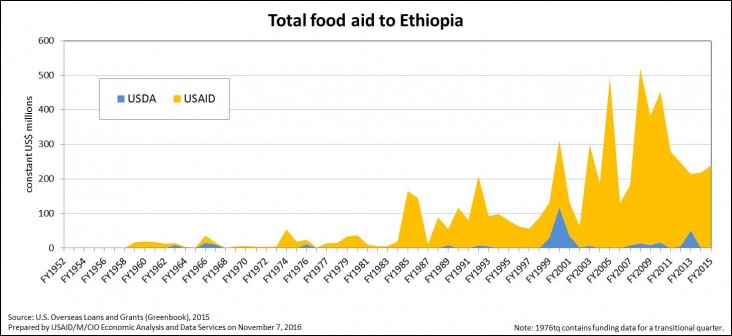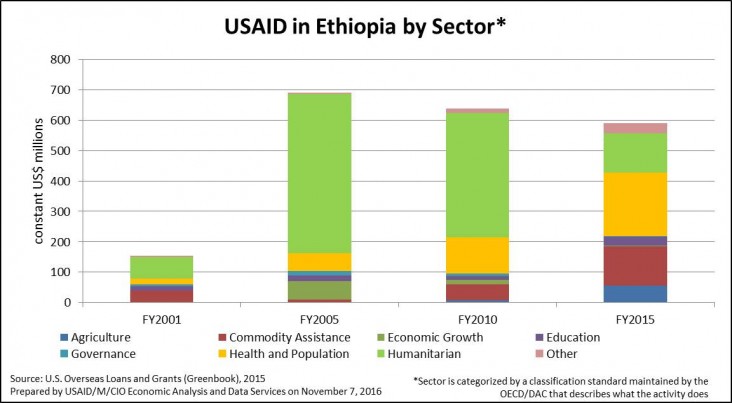Since its inception in 1961, USAID has provided assistance to Ethiopia. The U.S.-Ethiopian relationship was first established in 1903 and remained in good standing until the Italian occupation in 1935. After WWII, Ethiopia and the U.S. re-established their relationship, and in 1951 signed a treaty of amity and economic relations. Haile Selassie and Franklin Delano Roosevelt developed an amicable relationship over the latter’s opposition to British imposition after the British had liberated Ethiopia. Selassie was eager to “develop relations with the U.S. because he believed that the U.S. had no colonial aspirations” in Ethiopia. Consequently, on May 15, 1952, Ethiopia signed a Four Point Technical aid agreement and the U.S. commenced its activities in Ethiopia under the directorship of Herman Kleine and Selassie as Emperor and since 1961, USAID has continued and expanded on U.S. economic and development assistance to Ethiopia.
Ethiopia is important to the success of U.S. initiatives in the greater Horn of Africa because of its size, location and potential. Ethiopia has been a key player in trying to improve the ability of the countries in the region to prevent conflicts and improve overall food security and hence, avoid crises of drought and war, which have plagued the Horn.
Major turning points in USAID assistance to Ethiopia
There were two major turning points in USAID assistance to Ethiopia.
The first major turning point started with the 1973-1974 drought, which brought with it famines that claimed thousands of lives and displaced hundreds of thousands of people. This first episode of drought was followed by further episodes in the 1980s, 1990s and 2000s. Thus, USAID assistance came to include, in addition to the humanitarian assistance and emergency relief, drought recovery loans and food security programs.
The second major turning point came with the 1974 revolution, which brought in a military-led provisional Marxist regime, known as the Derg ruled by Major Mengistu Haile Mariam. As a result of the socialist revolution in Ethiopia, from 1974 U.S. democracy/governance and economic assistance was cut. Until the end of the Derg rule in Ethiopia, the U.S. provided for only humanitarian assistance. In 1992, after the overthrow of the military regime, the relationship between the two countries was normalized.
USAID programs in Ethiopia restarted in 1993. FY 1993 CBJ states that “[U]ntil this year, no U.S development assistance could be provided to Ethiopia because of legislative sanctions, including Section 518 of Foreign Operations, Export Financing, and Related Programs Appropriations Act of 1991, the “Brooke Amendment,” incurred by the former regime. All U.S. assistance since 1985 has been in the form of an emergency food and disaster relief program, conducted through NGOs. Subject to the resolution of outstanding Brooke sanctions, AID’s proposed transitional strategy will focus on support for the reconstruction of basic education facilities, importation of emergency pharmaceuticals, transportation equipment for the private sector, assistance in the prevention and control of AIDS, support for democracy and governance initiatives; training and technical assistance to advance economic reform, privatization of the fertilizer distribution system and the importation of industrial raw materials will be provided with private, voluntary and NGOs assistance. AID will continue its relief program through assistance to displaced persons, including demobilized soldiers, and a Title II program to address immediate food aid needs due to recurrent drought condition. Programs to support the integration of orphans into the community and provision of prosthetics for those disabled in the war will also be continued.” Consequently, upon resumption of USAID involvement in Ethiopia and the ouster of the Mengistu regime, democracy and governance initiatives became a part of USAID objectives in Ethiopia.
The overthrow of the military-led Marxist regime and the droughts that plagued Ethiopia in 1973-1974 and 1984-85 helped reformulate USAID’s objectives in Ethiopia. USAID objectives now included democracy, food security and health initiatives. USAID’s close work with the government in assistance programs in primary health and primary education began to function for the first time in 1995. Also, with the formation of the permanent-elected government, USAID’s assistance in democracy and governance moved away from elections and constitutional support to working with the newly elected National Parliament and strengthening local governments and judicial structures at both national and local levels.
USAID development priorities reflect evolution of Ethiopia over the years
The Congressional Budget Justifications give an insight into the evolution of USAID development priorities in Ethiopia over the years.
USAID Development priorities in the 1960s
Due to its strategic location in the Horn of Africa and as the site of an important U.S. military communications at Kagnew Station, Ethiopia received the third highest grant amounts behind Liberia and Nigeria. In addition, the U.S. took an overall interest in developing Ethiopia, “The U.S. program is directed primarily to the preconditions for development since Ethiopia’s development planning and performance are incomplete in many ways.” Consequently, throughout the 1960s USAID provided assistance for the following sectors: Agriculture, Natural Resources, Education, Health and Industry and Mining. Ethiopia was dominated by an agricultural economy, agriculture represented about two-thirds of GDP, occupied 90 percent of the population and earned virtually all of Ethiopia’s foreign exchange receipts and USAID concentrated a bulk of its assistance on the agricultural sector. The congressional budget justification for FY 1968 mentions that “the primary US objective is to help insure maintenance of a stable, cohesive and friendly government….” This CBJ goes on to insist that “the major thrust of AID assistance is to increase production in the cash economy” since one of Ethiopia’s most serious problems is its lack of government to support development projects.
Toward the end of the 1960s, AID objectives in Ethiopia expanded to include human capacity issues, although programs were largely focused on the agricultural sector. As of FY 1969, the main objectives of the AID program are to help Ethiopia:
- Increase its insufficient manpower by improving general education and training skills needed in the job market, and
- Raise its current inadequate government revenues by expanding the money sector of the economy through concentration on revenue producing activities in agriculture and related industries.
USAID Development Priorities in the 1970s
The FY 1970 CBJ outlines that the “major AID program objectives are to assist Ethiopia to mobilize its own resources and to expand the monetary economy by:
- Increasing commercial agricultural and industrial production,
- Developing manpower training and education, and
- Improving organizational and administration skills."
In addition, the congressional budget justification for FY 1970 mentions that “the AID program will continue the transition from concentration on institution building and infrastructure concentration to emphasis on revenue-producing activities.” Although the AID assistance approach changed from the 60s to the 70s, AID activities continued to be concentrated in the agricultural sector.
Due to the massive drought of 1973-1974 and its terrible costs to the Ethiopian people, USAID became involved in disaster relief. Thus, from this point USAID assistance to Ethiopia contained a drought recovery component, in addition to emergency assistance.
In terms of the evolution of the USAID assistance approach, the FY 1977 CBJ states “the United States has been assisting Ethiopia’s development since 1952. Assistance in 1952-1970 concentrated on developing infrastructure, institutions and manpower training. Since 1970 AID has concentrated on: rural development and education.” In stimulating rural development, AID assisted in Malaria control programs and education and human resource development.
Due to the 1974 revolution in Ethiopia and the political instability it created, USAID operated with increasing uncertainty toward the end of the 1970s. Consequently, USAID funding to Ethiopia dramatically decreased since 1976 and all assistance were in the forms of grants. Almost all grants from 1976 through 1979 focused on food and nutrition related programs.
USAID Development Priorities in the 1980s
Throughout the 1980s and early 1990s, USAID assistance to Ethiopia was reduced to humanitarian and emergency assistance. Due to sanctions, USAID pursued no programs in Ethiopia from 1981 through 1992.
USAID Development Priorities in the 1990s
USAID programs in Ethiopia restarted in 1993. FY 1993 CBJ states “Until this year, no U.S development assistance could be provided to Ethiopia because of legislative sanctions, including Section 518 of Foreign Operations, Export Financing, and Related Programs Appropriations Act of 1991, the “Brooke Amendment,” incurred by the former regime. All U.S. assistance since 1985 has been in the form of an emergency food and disaster relief program, conducted through NGOs. Subject to the resolution of outstanding Brooke sanctions, AID’s proposed transitional strategy will focus on support for the reconstruction of basic education facilities, importation of emergency pharmaceuticals, transportation equipment for the private sector, assistance in the prevention and control of AIDS, support for democracy and governance initiatives; training and technical assistance to advance economic reform, privatization of the fertilizer distribution system and the importation of industrial raw materials will be provided with private, voluntary and NGOs assistance. AID will continue its relief program through assistance to displaced persons, including demobilized soldiers, and a Title II program to address immediate food aid needs due to recurrent drought condition. Programs to support the integration of orphans into the community and provision of prosthetics for those disabled in the war will also be continued.” Consequently, upon resumption of USAID involvement in Ethiopia and the ouster of the Mengistu regime, democracy and governance initiatives became a part of USAID objectives in Ethiopia.
The overthrow of the military-led Marxist regime and the droughts that plagued Ethiopia in 1973-1974 and 1984-85 helped reformulate USAID’s objectives in Ethiopia. USAID objectives now included democracy, food security and health initiatives. USAID’s close work with the government in assistance programs in primary health and primary education began to function for the first time in 1995. Also, with the formation of the permanent-elected government, USAID’s assistance in democracy and governance moved away from elections and constitutional support to working with the newly elected National Parliament and strengthening local governments and judicial structures at both national and local levels.
Throughout the 1990s USAID developed “sustainable development goals” and Mission strategic objectives based on these agency goals.
Strategic Objectives by Agency Goals
Agency Goal: Encouraging Broad-Based Economic Growth
SO 1: Increased Availability of Selected Domestically Produced Food Grain Crops
SO 3: Quality and Equity of Primary Education Improved in an Expanded System
Agency Goal: Stabilizing World Population Growth and Protecting Human Health
SO 2: Increased use of primary and preventative health care services
Agency Goal: Building Democracy
SO 4: Increased access to and participation in a democratic system
Agency Goal: Humanitarian Assistance
Specific Objective 1: Emergency humanitarian assistance provided to most vulnerable groups.
Throughout the 1990s, USAID assistance focused on program supporting strategic objectives 1 and 2.
USAID Development Priorities in the 2000s
Toward the end of the 1990s, education started to become a more important objective for USAID. Consequently, throughout the 2000s, funding allocations indicate that funds were greatly focused on programs supporting the health and education objectives.
From 2002 through 2005, USAID strategic objectives in Ethiopia were slightly altered and expanded.
Strategic Objectives
SO1: Food Security
SO2: Essential Services for Health
SO3: Basic Education
SO4: Democracy and Governance
SO5: Mitigate the Effects of Disaster
SO6: Southern Tier Initiative
Strategic objective 5 and 6 were added due to the 2002-2003 drought, which demonstrated the “fragility of Ethiopia’s social and economic condition. For FY 2004-2005, funding allocations indicate that funding was more focused on programs, which supported strategic objectives 2, 3 and 5. According the FY 2006 CBJ, “USAID revised its current strategy in mid-FY 2004 in response to the shortening cycle of crises, the HIV/AIDS pandemic and the need to invest more in economic growth and policy reform.” Consequently, the strategic objectives were once again reformulated and presented in the FY 2006 CBJ.
Strategic Objectives
SO1: Anticipate and Manage Shocks
SO2: Human Capacity
SO3: Governance Capacity
SO4: Economic Growth
SO5: Knowledge Management
For FY 2006 and FY 2007, funding allocations indicate the funds were more focused on program supporting strategic objective 2 and 4.
In FY 2008 strategic objectives were once again renamed and reformulated and this categorization continued through 2011.
Strategic Objectives and Program Categories for Each Objective
Peace and Security
Counter-Terrorism
Stabilization Operations and Security Sector Reform
Conflict Mitigation and Reconciliation
Governing Justly
Rule of Law and Human Rights
Good Governance
Political Competition and Consensus Building
Civil Society
Investing in People
Health
Education
Social Services and Protection for Especially Vulnerable People
Economic Growth
Trade and Investment
Agriculture
Private Sector Competitiveness
Economic Opportunity
Environment
Humanitarian Assistance
Protection, Assistance and Solutions
Disaster Readiness
From 2008 through 2011, funding allocations indicate that funds are greatly focused on programs supporting the objectives: Investing in People and Economic growth. In addition, since FY 2009 there has been a jump in funding for programs supporting Peace and Security.
Funding levels for Ethiopia over the years
Since its initial involvement, the U.S. Government, through the Agency for International Development and predecessor agencies, has assisted the Ethiopian Government’s development program in numerous activities in the fields of agriculture, health, education, relief and rehabilitation, industry, transportation, public safety and public administration, community development, social welfare and housing, communications media and private enterprise.
From 1951 through September 30, 2013, the U.S. Government provided through the Agency for International Development and predecessor agencies, approximately $11.7 billion in economic assistance to Ethiopia. (in constant dollars)
USAID and Predecessor Loans and Grants / Food Aid to Ethiopia, FY1952 - 2013 [PDF, 103KB]



Data Source: U.S. Overseas Loans and Grants (Greenbook)
The amounts presented in the graphs above are in constant 2013 USD to allow for cross-time comparisons.
Selected historical development accomplishments USAID has achieved in Ethiopia
Agriculture and Food Security
- Agricultural cooperative activities have facilitated the restructuring of 112 farmer cooperatives into business-oriented enterprises with democratically elected Boards of Directors. Additionally, eight cooperative unions (whose members are farmer cooperatives) were established to economize the purchase of inputs (primarily fertilizer) and crop marketing.
- In the 1970’s, four agricultural sector programs totaling $40 million to assist the Ethiopian Government in expanding its agricultural development. The Ethiopians Government’s agricultural development programs, supported by these loans include assistance to small peasant farmers through the provision of fertilizer, seeds, extension education, cooperative development, livestock disease control, credit, rural roads and research.
Health and Nutrition
- Health sector assistance is improving public health delivery .by supporting a preventive, primary health care approach.
- USAID has played a critical role in raising the use of contraceptives in Ethiopia and increasing rates of child survival of children under five years of age.
- The development of the Malaria Eradication Service now renamed the Malaria Control Service.
- PL 480 Title II commodities supported maternal/child health (MCH) activities in urban and rural areas in order to alleviate the nutritional deficiency of the recipients. In the MCH program, the major recipients/beneficiaries were pre-school children, mothers and at risk females totaling 43 percent of the population. The commodities consist mainly of corn soya milk, soy fortified sorghum grits and oil.
Education
- The establishment of the Public Health College in Gondar. Construction, equipping and the staffing of the College of Agriculture at Alemaya largely through a contract with Oklahoma State University.
- USAID assistance contributed to a dramatic increase in the primary school gross enrollment rate, from 24 percent in FY 1995, to 62 percent FY 2002, exceeding the FY 2002 target. Enrollment for girls in USAID’s two focus regions showed remarkable growth, from 38 percent in 1995, to 76 percent in 2002 in one area and from 17 percent in 1995, to 51 percent 2002 in another.
- The construction, staffing and equipping of the Awassa Community Development Training Center and the expansion of facilities at the Agricultural schools in Jimma and Ambo, vocational trade schools in Addis Ababa and Asmara, the Teacher Training School in Harar and the Regional Secondary School in Debre Berhan. A dormitory and a classroom building at Alemaya College (now Haromaya University).
- At Addis Ababa University, construction of the John F. Kennedy Library, AAU faculty and staff development, funding in research and other institution building activities, financing for the design, equipping and construction of six dormitories, a cafeteria, and an auditorium and two lecture halls.
Policy and Institutional Development
- USAID’s activities have contributed to progress in: decentralizing and reforming budget and accounts; preventing and mitigating local conflict
- USAID support to improve the Government of Ethiopia's capacity to anticipate and manage shocks yielded several key achievements that saved thousands of lives in the most recent food emergencies. Improved contingency planning involving donors and government stakeholders resulted in the anticipation of emergency needs in health, water, and agricultural sectors.
- USAID’s policy work with the Government of Ethiopia enabled reform of the emergency response system in nine regions, which differentiated between acute and chronic food insecure populations, allowing for more effective and appropriate targeting of assistance to each group. This intervention also improved non-food emergency needs and strengthened the appeals and assessment process, focused on identifying acute emergency needs versus predictable yearly support.
- A development assistance group, of which USAID is a key member, helped the GFDRE to develop its poverty reduction plan, review public expenditures annually and promote better public financial management.
Infrastructure
- Provision of project loans to the Ethiopian Highway Authority now the Ethiopian Road Authority for road construction, for the installation of 34 bailey bridge sections at locations throughout the country and for equipment and repair facilities.
- Assistance in the development of Ethiopian Airlines under an earlier contract with TWA, and the improvement of transportation within the country and to points abroad through loans for airport development in Addis Ababa, Asmara, Jimma and elsewhere and jet aviation maintenance and repair facilities.
Evolution of USAID Development Priorities in Ethiopia: Details of USAID programs and funding from 1961-2013 [PDF, 324KB]








Comment
Make a general inquiry or suggest an improvement.